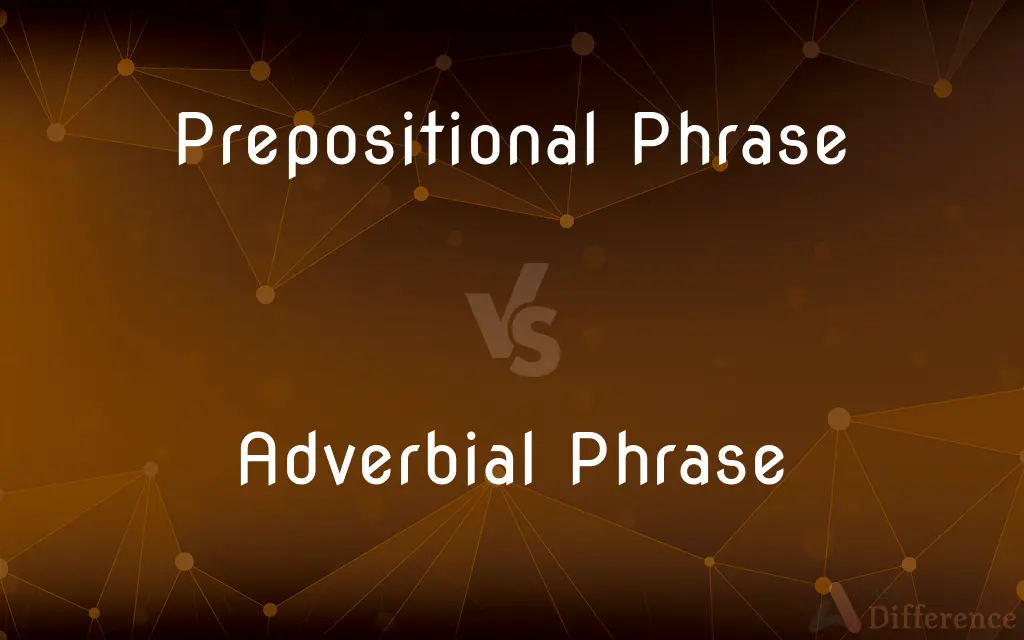Prepositional Phrase vs. Adverbial Phrase — What's the Difference?
By Tayyaba Rehman — Published on November 29, 2023
A prepositional phrase begins with a preposition and includes an object. An adverbial phrase modifies a verb, an adjective, or another adverb, providing additional information.

Difference Between Prepositional Phrase and Adverbial Phrase
Table of Contents
ADVERTISEMENT
Key Differences
A prepositional phrase is a linguistic structure that starts with a preposition and is followed by a noun or pronoun, referred to as the object of the preposition. The prepositional phrase gives more information about other words in a sentence, typically describing location, direction, or time. For example, the prepositional phrase "on the table" provides specifics regarding where something is placed.
On the contrary, an adverbial phrase functions primarily to modify a verb and provide the reader or listener with more details about how, when, where, why, or how much an action occurs. The adverbial phrase "very quickly" in the sentence "She ran very quickly," for instance, offers additional information about the manner of the action denoted by the verb "ran."
Prepositional phrases can act as either adverbial or adjectival phrases. An example where it acts adverbially might be: "He works on weekends," where "on weekends" describes when he works. However, it’s critical to note that not all adverbial phrases are prepositional. For example, the adverbial phrase "too slowly" modifies a verb but isn’t prepositional.
While both prepositional and adverbial phrases serve the purpose of adding information to sentences, the type of information and the way they modify sentence elements differ distinctly. A single prepositional phrase can function adjectivally or adverbially, whereas an adverbial phrase delivers further insight into the verbs, adjectives, or adverbs.
The distinction between prepositional and adverbial phrases thereby hinges on their construction and function. Recognizing their roles in a sentence is vital for crafting comprehensive and precise expressions in language, enhancing clarity, and facilitating a deeper understanding of the content.
ADVERTISEMENT
Comparison Chart
Basic Structure
Preposition + Object
Modifies verb, adjective, or adverb
Function in Sentence
Can act adverbially or adjectivally
Specifically modifies verbs
Example
In the garden
Quite slowly
Modifies
Nouns or verbs
Verbs, adjectives, or adverbs
Additional Info
Gives info about place, time, etc.
Provides details how/when/where, etc.
Compare with Definitions
Prepositional Phrase
A prepositional phrase acts to modify nouns, verbs, or clauses.
The letter from John made her day.
Adverbial Phrase
They describe the manner, place, time, frequency, degree, or reason of the action.
The bird sang beautifully.
Prepositional Phrase
Prepositional phrases start with a preposition and have a noun or pronoun object.
The cat slept on the sofa.
Adverbial Phrase
It can be a group of words that collectively functions as an adverb.
They lived happily ever after.
Prepositional Phrase
They typically provide context regarding "where," "when," or "in what manner."
The books are under the table.
Adverbial Phrase
An adverbial phrase isn’t bound to a particular structure like prepositional phrases.
She finished the task quite efficiently.
Prepositional Phrase
Prepositional phrases can function as adjectives or adverbs in sentences.
The gift inside the box is for you.
Adverbial Phrase
Adverbial phrases modify verbs, adjectives, or other adverbs, providing more details.
She walks extremely fast.
Prepositional Phrase
They provide additional information, often related to time, place, or manner.
We went to the store after dinner.
Adverbial Phrase
Adverbial phrases can be placed at various positions in a sentence.
The children played outside.
Common Curiosities
Can a prepositional phrase function adverbially?
Yes, prepositional phrases can function both adverbially and adjectivally in sentences.
What is the primary function of an adverbial phrase?
An adverbial phrase primarily modifies a verb, adjective, or another adverb, providing additional information.
What is a prepositional phrase?
A prepositional phrase is a group of words beginning with a preposition and usually followed by a noun or pronoun.
What is the structure of a prepositional phrase?
A prepositional phrase is structured with a preposition followed by its object (a noun or pronoun).
What can adverbial phrases modify?
Adverbial phrases can modify verbs, adjectives, and other adverbs.
Are all prepositional phrases also adverbial phrases?
No, while prepositional phrases can act as adverbial phrases, they can also function as adjectival phrases.
Can adverbial phrases appear anywhere in a sentence?
Yes, adverbial phrases can be positioned at the beginning, middle, or end of a sentence.
How does a prepositional phrase provide additional information?
It can clarify details regarding location, time, or manner concerning other words in a sentence.
Do adverbial phrases have a fixed position in a sentence?
No, adverbial phrases can be placed flexibly within sentences based on the desired emphasis.
Can an adverbial phrase begin with a preposition?
Yes, some adverbial phrases start with a preposition, but not all of them do.
Can a sentence have multiple prepositional phrases?
Yes, a sentence can contain more than one prepositional phrase.
Are adverbial phrases crucial in sentence formation?
While not always essential, adverbial phrases enrich sentences by providing additional details.
Is it possible for an adverbial phrase to consist of one word?
Yes, adverbial phrases can be single adverbs or a group of words functioning as an adverb.
What roles do prepositional phrases play in sentence construction?
Prepositional phrases can act as adjectives or adverbs, modifying nouns, verbs, or clauses.
Can a sentence exist without a prepositional phrase?
Absolutely, prepositional phrases enhance details but are not mandatory for sentence construction.
Share Your Discovery

Previous Comparison
Colgate vs. Pepsodent
Next Comparison
Uggs vs. BearpawsAuthor Spotlight
Written by
Tayyaba RehmanTayyaba Rehman is a distinguished writer, currently serving as a primary contributor to askdifference.com. As a researcher in semantics and etymology, Tayyaba's passion for the complexity of languages and their distinctions has found a perfect home on the platform. Tayyaba delves into the intricacies of language, distinguishing between commonly confused words and phrases, thereby providing clarity for readers worldwide.
















































